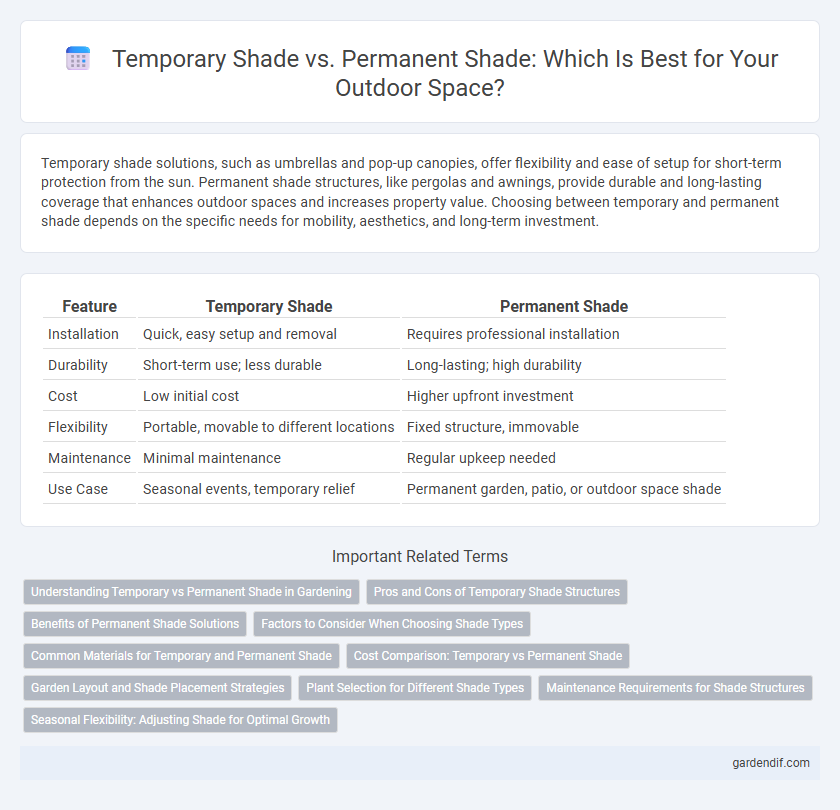
Temporary Shade vs Permanent Shade Illustration
Temporary shade solutions, such as umbrellas and pop-up canopies, offer flexibility and ease of setup for short-term protection from the sun. Permanent shade structures, like pergolas and awnings, provide durable and long-lasting coverage that enhances outdoor spaces and increases property value. Choosing between temporary and permanent shade depends on the specific needs for mobility, aesthetics, and long-term investment.
Table of Comparison
| Feature | Temporary Shade | Permanent Shade |
|---|---|---|
| Installation | Quick, easy setup and removal | Requires professional installation |
| Durability | Short-term use; less durable | Long-lasting; high durability |
| Cost | Low initial cost | Higher upfront investment |
| Flexibility | Portable, movable to different locations | Fixed structure, immovable |
| Maintenance | Minimal maintenance | Regular upkeep needed |
| Use Case | Seasonal events, temporary relief | Permanent garden, patio, or outdoor space shade |
Understanding Temporary vs Permanent Shade in Gardening
Temporary shade solutions in gardening, such as shade cloths, umbrellas, or removable pergolas, provide flexibility by protecting plants from intense sunlight during critical growth periods or heatwaves. Permanent shade structures like trees, arbors, or fixed gazebos offer consistent, long-term protection, improving plant health and reducing soil moisture loss by creating stable microclimates. Understanding the specific needs of your garden plants and local climate conditions helps determine whether temporary or permanent shade is more effective for maximizing growth and sustainability.
Pros and Cons of Temporary Shade Structures
Temporary shade structures offer flexibility and ease of installation, making them ideal for seasonal use or short-term events. They typically cost less upfront compared to permanent shades but may require frequent maintenance and replacement due to weather exposure. However, their portability allows quick removal or repositioning, which can be less durable and stable than permanent shade solutions.
Benefits of Permanent Shade Solutions
Permanent shade solutions offer durable protection against UV rays and reduce heat buildup, enhancing outdoor comfort year-round. They require minimal maintenance compared to temporary options, providing cost-efficiency over the long term. Structures like pergolas and awnings also add aesthetic value and increase property appeal.
Factors to Consider When Choosing Shade Types
Choosing between temporary shade and permanent shade requires evaluating factors such as intended usage duration, climate conditions, and budget constraints. Temporary shade structures like pop-up canopies offer flexibility and portability, ideal for seasonal or event-based needs, whereas permanent shade solutions like pergolas or awnings provide durable protection and enhance property value. Assessing maintenance requirements and aesthetic preferences also influences the optimal choice for effective sun protection.
Common Materials for Temporary and Permanent Shade
Temporary shade structures commonly use materials like fabric canopies, mesh tarps, and lightweight metals such as aluminum for frames, allowing for easy setup and portability. Permanent shade installations often incorporate durable materials including wood, steel, and polycarbonate panels, providing long-lasting protection and structural stability. Selection depends on factors like climate, intended use, and maintenance requirements, impacting the overall effectiveness and longevity of the shade solution.
Cost Comparison: Temporary vs Permanent Shade
Temporary shade solutions typically incur lower upfront costs due to materials like fabric canopies and portable structures, making them cost-effective for short-term use. Permanent shade installations, such as pergolas or metal awnings, require higher initial investment but offer long-term durability and reduced maintenance expenses. Over time, permanent shade often proves more economical for continuous use despite the larger initial expenditure.
Garden Layout and Shade Placement Strategies
Temporary shade solutions like retractable awnings and shade sails offer flexibility in garden layout by allowing seasonal adjustment of shade placement based on sun patterns, benefiting plant health and outdoor comfort. Permanent shade structures such as pergolas and gazebos provide consistent coverage, enabling strategic placement to protect delicate plants and create designated relaxation areas within the garden. Optimizing shade placement involves analyzing sun exposure angles and plant requirements to balance light and shade, enhancing garden aesthetics and functionality year-round.
Plant Selection for Different Shade Types
Plant selection for temporary shade often includes fast-growing annuals or shade-tolerant perennials that thrive under intermittent sunlight, such as impatiens or ferns. Permanent shade favors species adapted to consistently low light conditions, like hostas, astilbes, or certain types of mosses that require minimal direct sunlight. Understanding the duration and intensity of shade helps optimize plant health and growth by matching species to their specific light environment.
Maintenance Requirements for Shade Structures
Temporary shade structures require minimal maintenance, often involving straightforward setup, occasional cleaning, and inspection for wear or damage after use. Permanent shade installations demand routine maintenance such as periodic cleaning, structural inspections, repainting or sealing surfaces, and repairs to weather-related damage to ensure longevity. Choosing between temporary and permanent shade depends heavily on the desired durability, installation complexity, and ongoing maintenance commitment.
Seasonal Flexibility: Adjusting Shade for Optimal Growth
Temporary shade structures offer seasonal flexibility by allowing gardeners to adjust shading according to plant growth cycles and changing sunlight intensity, promoting optimal photosynthesis and healthier crops. Permanent shade installations provide consistent protection but lack adaptability, which can limit light availability during different seasons and affect plant development. Balancing temporary and permanent shade solutions supports dynamic environmental control, ensuring plants receive the right light exposure for peak growth throughout the year.
Temporary Shade vs Permanent Shade Infographic

 gardendif.com
gardendif.com